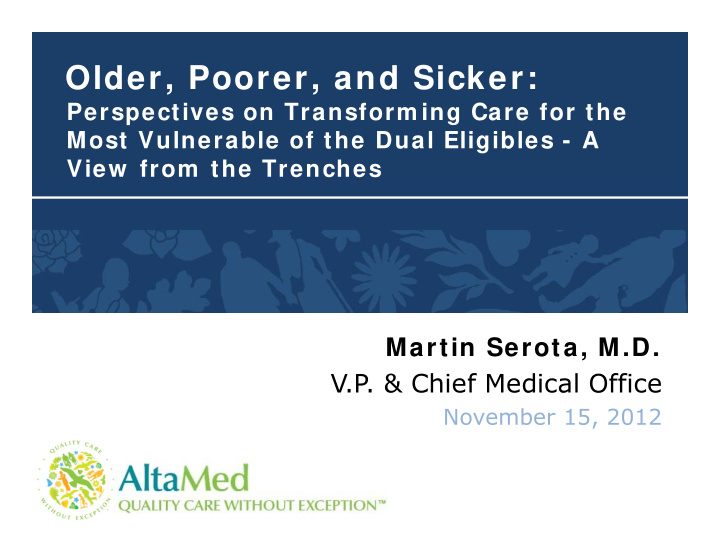



Older, Poorer, and Sicker: Perspectives on Transform ing Care for the i f i C f h Most Vulnerable of the Dual Eligibles - A View from the Trenches View from the Trenches Martin Serota, M.D. V P & Chief Medical Office V.P. & Chief Medical Office November 15, 2012
AltaMed-Facts One of nation’s largest FQHC’s, with wrap-around One of nation s largest FQHC s, with wrap around IPA PCMH certified by TJC and NCQA 73% earn less than $44 700/year for a family of 73% earn less than $44,700/year for a family of four Take all insurance types; 27% have no insurance 81% of our patients are Latino 1,900 employees across 43 sites 125,000 patients served; 930,000 annual visits 125,000 patients served; 930,000 annual visits 140 providers, mid-level practitioners 600 contracted specialists
3
W hat w e learned from the SPD’s Medical management resources had to be g grown quickly HRA’s can be done by the group faster and more accurately Group case management can reduce utilization more than by health plan tili ti th b h lth l Less confusion of patient Better communication access to EHR Better communication, access to EHR SPD utilization is 120% of Medicare HMO
Our Medical Managem ent Model Strive for full delegation Strive for full delegation All patients get HRA and tiering Central team Central team Clinic team Hospital team Hospital team ACN team Transitions of care model Transitions of care model
Case Managem ent: Case Study 64 yr old male 64 yr old male Symptomatic BPH Symptomatic BPH Muscular Lumbago Dystrophy Dystrophy Pressure Ulcer Pressure Ulcer Hepatitis C Generalized HTN HTN Weakness Weakness DM Dental Caries Chronic Pain Chronic Pain
Psychosocial I ssues Depression Depression Unstable Living Arrangement Insomnia Insomnia History of IV Drug Abuse Pain Medication Seeking Behavior Pain Medication Seeking Behavior
Overall utilization 4-23-10: ER admit for Syncope 4-26-10: ER admit for Syncope 5-13-10: ER admit for OD/Suicide Attempt 5 17 10: ER admit for Suicidal ideation 5-17-10: ER admit for Suicidal ideation 5-21-10: Admit for Drug Withdrawal Sx 6-10-10: Admit for Diabetic complications/neuropathy 7-9-10 to 9-21-10: Multiple USC specialty follow-up evals with evals with GI/Neurology GI/Neurology Needs GT for dysphagia/weight loss/generalized weakness but patient refused
8 -1 0 -1 0 starts Com plex Case Managem ent g Care Coordination with Specialists/PCP Care Coordination with Specialists/PCP Patient Education Lifestyle Modification Lifestyle Modification Social Services Continuous Patient Education Continuous Patient Education Routine Calls to Patient and Patient’s Family for Family for continuous support continuous support Interdisciplinary Team Meetings
Positive outcom es Patient moved out of Garage with no Patient moved out of Garage with no bathroom to a Residential Facility GT placement 8-2011 GT placement 8 2011 Improved Family Social Support Methadone Treatment Program Methadone Treatment Program Compliance with Medications, PCP and Specialist Follow- ups p p 2 ER visits: 11-29-11 & 7-9-12
Case Managem ent: Results
Success Factors Small panel size Interdisciplinary teams di i li Fully integrated care More services at point of care More services at point of care More personal “touches” Intense Medical Management g Transportation Social Services Extended Hours E d d H Aligned financial incentives-role of contracting
W orkforce Challenges Duals are currently cared for by providers that are not in managed care and are not board certified S Spanish-speaking health workers, i h ki h lth k especially behavioral health, are scarce Will there be enough PCP’s? Will there be enough PCP s?
Resource Challenges Long term care facilities Long term care facilities Skilled nursing facilities Adeq ate f nding? Adequate funding?
Patient Challenges Patients will be sicker with more Patients will be sicker, with more psychosocial needs Obtaining patient input in process design Obtaining patient input in process design Obtaining patient engagement and compliance p Different payers require different processes
Contracting Challenges Do we understand cost/risk of the Duals Do we understand cost/risk of the Duals What is the cost/opportunity of LTC? Is there enough money after everyone Is there enough money after everyone takes their margin? Full delegation of medical management? Full delegation of medical management? Uniform DOFR?
Hospital/ Medical Group Challenges Hospitals see their revenue and influence Hospitals see their revenue and influence decreasing Want to: Increase market share Redefine their role ─ “Employ” providers ─ Be integrators of care ─ Be owners, not vendors B t d Hospitals need to safely change financial models models
Other System Challenges Retail pharmacies are not adequately Retail pharmacies are not adequately integrated into the system CHC collaboration CHC collaboration Safety-net coordination
Technology Challenges The value of technology grows The value of technology grows exponentially with the # of external inputs – so does the complexity and cost p y HIPAA Master Patient Index Cost/ROI
W hat it feels like...
W here W e Need to I nvest Standardization Benefit design Benefit design DOFR Workforce Evaluation of providers, especially non-board certified Training of culturally sensitive, bilingual staff, especially behavioral health Best methods of patient input and engagement Patient education regarding palliative and hospice care Patient education regarding palliative and hospice care Design all inclusive systems of care Alternative payment models that go beyond PCMH to include all care settings Medication reconciliation with retail pharmacies Technology Master Patient Index Health Info mation E change Health Information Exchange
Sum m ary The lines are blurring betw een “traditional” and “safety net” providers – how do we best care for new populations entering managed care? Patients: Will be sicker be s c e Have greater psychosocial needs Providers: Need enhanced medical management capabilities Need enhanced medical management capabilities Need enhanced IT ─ Recordkeeping – EHR ─ Communication – portals, HIE, MPI ─ Analytics W e need to get it right! W e need to get it right!
Recommend
More recommend